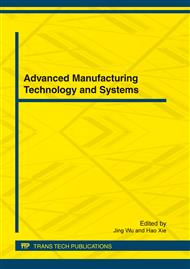p.79
p.84
p.88
p.93
p.99
p.104
p.109
p.115
p.122
Effect of Insert Style in Milling of Titanium Alloy (TC18)
Abstract:
Titanium alloy (TC18) is new style alloy (α+β). It possesses better performances than common titanium alloy. However, Titanium alloy (TC18) is still classified as difficult-to-machine materials for their poor machinability, which is attributed to relatively low modulus of elasticity, strong alloying tendency or chemical reactivity with cutting materials at higher temperatures and low conductivity of heat generated by the cutting action. Due to the poor machinability of the alloys, selecting of insert style is crucial for tool life and material removal rate. In this work, milling tests, using three kinds of inserts (KC522M, YD201 and SANDVIK 4240), were carried out on this kind of titanium alloy (TC18). The results of tests show that the material removal rate of insert KC522M is the highest, but its tool life is shorter compared with insert SANDVIK 4240. The material removal rate and tool life of insert YD201 do not draw the attention because both of them are relatively low. The abrasion speed of insert SANDVIK 4240 is slow and the efficiency is high, so it is ideal for machining titanium alloy (TC18). In addition, the optimal machining parameters of insert SANDVIK 4240 for milling titanium alloy (TC18) were also given in this paper.
Info:
Periodical:
Pages:
99-103
Citation:
Online since:
March 2012
Authors:
Price:
Сopyright:
© 2012 Trans Tech Publications Ltd. All Rights Reserved
Share:
Citation:


